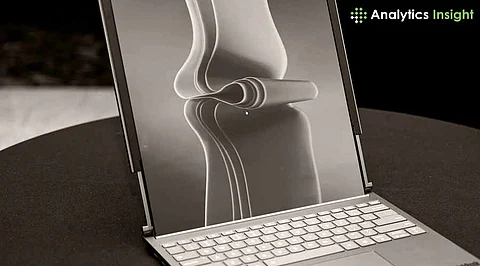

The rollable display technology looks like ushering the future generation of the laptop industry into a revolution. This innovation is going to change the face of portability, yet still maintain functionality and user experience consistently between the laptop and the mobile device.
Flexible OLED technology used in rollable displays enables screens to expand or retract without a gap or seam. Devices can provide larger display area without corpus on portability because of this adaptability. What used to contain the concept as little more than prototypes and exhibitions has morphed into reality as tangible, consumer-friendly products.
The ThinkBook Plus Gen 6 is a commercially available rollable display laptop, introduced by Lenovo at the Consumer Electronics Show (CES) 2025. This device has a 14-inch OLED screen, which by extending vertically can grow to 16.7in, or around 50% more screen space. A technique of dedicated buttons or hand gestures, the transformation is a mix of first-class innovation and user-centric design.
Powered by Intel’s Core Ultra 7 processor, the ThinkBook Plus Gen 6 comes with up to 32GB of DDR5 RAM and a 1TB solid-state drive. The OLED display has a 120Hz refresh rate, 400 nits brightness, and 100% DCI-P3 colour accuracy, so you’ll get specially crafted visuals and great performance. It weighs around 3.73 pounds, which is slightly less than you’d expect from a modern laptop, with advanced features.
Coming soon to a PC near you: the ThinkBook Plus Gen 6, priced at $3,499 and set to launch during the first quarter of 2025. The premium pricing reflects the novel technology of rollable displays in consumer electronics and the fact that this is cutting-edge. The primary target audience is people who are early adopters and tech geeks, building a path for wider market appeal down the road.
Lenovo ThinkBook Plus Gen 6 Rollable: Industry-first consumer rollable laptop with seamless vertical expansion and high durability.
LG Rollable OLED Display Laptop: New innovative OLED technology gives enhanced picture quality and extreme flexibility in constructing furniture.
Asus ZenBook Rollable Concept: Integration of innovative features such as a build quality that indicates the use of expensive material, and a rollable display feature.
Samsung Rollable Laptop Display: High-tech display accessories suitable to custom fit within multiple brands.
Dell Rollable Concept XPS Prototype: Sleek design and exceptional performance potential for professional workflows.
The flexible panels for Lenovo's ThinkBook Plus Gen 6 come from Samsung Display, which helped with the collaborative effort to produce rollable OLED screens. It serves as proof of the industry's desire to move the scene forward in display technologies and possibly a foretaste of manufacturing trends as well. As more manufacturers start rolling displays, rollable displays could bring economies of scale to reduce cost, which is likely to increase adoption across different device categories.
Despite the promising advancements, rollable laptops face several challenges. Software optimization is necessary to fully leverage the dynamic display sizes, as current operating systems may not seamlessly support such flexibility. Additionally, the mechanical components responsible for rolling and unrolling the display must be robust enough to withstand regular use without compromising the device's longevity. The ThinkBook Plus Gen 6 Rollable, for example, has been tested to endure at least 30,000 lid movements and 20,000 screen rolls, indicating a focus on durability.
The introduction of rollable displays in laptops signifies a potential shift in personal computing. This technology offers a solution to the perennial trade-off between screen size and portability, catering to professionals and creatives who require expansive displays without sacrificing mobility. As manufacturing processes mature and software ecosystems adapt, rollable laptops could become a mainstream choice for consumers seeking versatile computing solutions.
Rollable display technology is not just a new view on the laptop industry, but a new way to integrate the two terms: innovation and practice. Challenges remain, but the work to solve these challenges together is apparent with industry partners like Lenovo and Samsung Display. At the same time, it promises to enable users once unthinkable flexibility and functionality in personal computing, ushering in a new era of computing.
